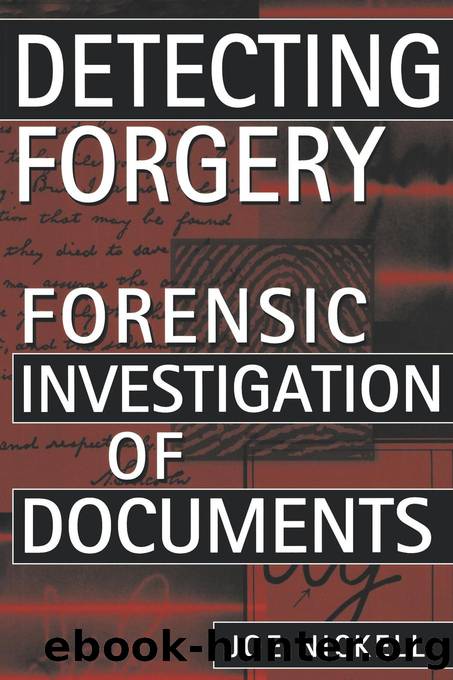Detecting Forgery by Nickell Joe;

Author:Nickell, Joe; [Nickell, Joe]
Language: eng
Format: epub
Publisher: University Press of Kentucky
Published: 2021-08-15T00:00:00+00:00
Figure 4.8. Pre-envelope letters were sealed with paste wafers or blobs of sealing wax. At left is an opened letter sheet showing the manner of folding. (At bottom center of the sheet is a piece of paper adhering to the wafer.) At upper right is a similar sheet folded into its packet, and below it is the reverse of another packet, showing how the wax seal was placed over the fold. Postmarks might be placed anywhere on either side of a letter packet, as shown by these examples.
While pre-envelope letters were usually sealed with wax or wafers (the latter placed under the flap) (figure 4.8), envelopes invited a variety of closing devices. Not common until the 1840s, envelopes were closed with mucilage; âmotto sealsâ (small printed stickers occasionally used circa 1850); imitation seals made of embossed, glossy red paper; and other devices. The adhesive or âself-sealingâ envelope (of about the late 1840s) eventually prevailed, but the clasp envelope (patented in 1879) also remains common.
Since the pre-envelope covers also bore postmarks (figure 4.8), they represent another challenge for the forger. Hofmann, for example, faked a postmark on the address panel of his folded âwhite salamanderâ letter but, as an expert reported, âthe flatness, vagueness, and ink distribution of the postmark differ from genuine postmarks of the period.â70 For an address-leaf of a forged letter by Abraham Lincoln, Joseph Cosey created a postmark by using an inked bottle top to produce the circle, and printing the wording, âALTON 7 CENTRAL ILLINOIS R. R. DEC. 6, 1847,â with a childâs rubber-stamp outfit. (In places the letters overlapped the circle, a tip-off that the postmark was produced in two stages.)71
After adhesive postage stamps were introduced (in Britain in 1840 and in the United States in 1847), cancellation devices joined postmarks on address leafs (and later envelopes). Eventually the two were combined, but early stamps were typically canceled with pen and ink (with an âX,â slash marks, etc.) and are known as âpen cancellations.â âCork cancellationsâ (improvised from a cork stopper into the end of which a simple design, such as a cross, was cut) were also much used. âTarget cancellationsâ (a simple design of concentric circles) were common throughout the latter half of the nineteenth century. âFlag cancellationsâ were produced by canceling machines and first appeared in 1894.
In addition to the type of fakery produced by the likes of Cosey and Hofmann, forgers are now using phony postmarks and cancellations to create bogus postal collectibles. For example, a particular Confederate stamp is more valuable in used rather than mint condition (since it was produced at the end of the Civil War and few were actually used). By investing several dollars in an unused specimen, affixing it to an old envelope, and adding the address and fake postal marking, the forger has attempted to triple his investment.
Similarly, penny ante fakers are also enhancing the value of âpatriotic covers.â (Common during the Civil War, these are small envelopes printed with decorative cachets, most commonly expressing proloyalist or antisecessionist sentiments.
Download
This site does not store any files on its server. We only index and link to content provided by other sites. Please contact the content providers to delete copyright contents if any and email us, we'll remove relevant links or contents immediately.
| Annotations & Citations | Law School Guides |
| Legal Profession | Legal Writing |
| Test Preparation |
Master of the Game by Sidney Sheldon(1888)
GRE Premier 2017 with 6 Practice Tests by Kaplan(1506)
Law School Essays that Made a Difference by Princeton Review(1468)
Law: A Very Short Introduction by Raymond Wacks(1388)
A Life of Crime by Harry Ognall(1382)
Objection! by Nancy Grace(1333)
Examples & Explanations: Administrative Law by William F. Funk & Richard H. Seamon(1332)
Philosophy of law a very short introduction by Raymond Wacks(1300)
Writing to Win: The Legal Writer by Steven D. Stark(1284)
College Essays that Made a Difference by Princeton Review(1270)
Cracking the SAT Premium Edition with 6 Practice Tests, 2017 by Princeton Review(1255)
Sidney Sheldon (1982) Master Of The Game by Sidney Sheldon(1192)
GMAT For Dummies by Lisa Zimmer Hatch & Scott A. Hatch(1188)
Civil Procedure (Aspen Casebooks) by Stephen C. Yeazell(1180)
Drafting Contracts: How and Why Lawyers Do What They Do, Second Edition by Stark Tina L(1175)
Storytelling for Lawyers by Meyer Philip(1140)
Graduate Admissions Essays, Fourth Edition: Write Your Way into the Graduate School of Your Choice by Donald Asher(1138)
So You Want to be a Lawyer by Lisa Fairchild Jones Esq(1103)
INDEFENSIBLE: One Lawyer's Journey Into the Inferno of American Justice by Feige David(1012)
